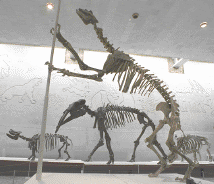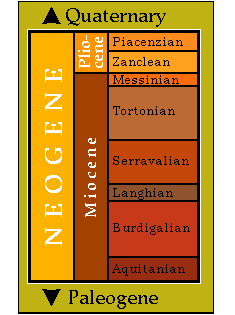
The Miocene Epoch
23.8 to 5.3 mya
At right is pictured (in front),
Chalicotherium, a Miocene mammal
from Kazakhstan. Chalicotherium was an unusual "odd-toed hoofed
mammal, or perissodactyl.
Both the perissodactyls and artiodactyls
underwent a period of rapid evolution during the Miocene.
The Miocene was a time of warmer global climates than those in the preceeding
Oligocene, or the following Pliocene. It is particularly notable in that
two major ecosystems first appeared at this time:
kelp forests and
grasslands.
The expansion of grasslands is correlated to a drying of continental
interiors as the global climate first warmed and then cooled.
Global circulation patterns changed as Antarctica became isolated and the
circum-polar ocean circulation became established. This reduced significantly
the mixing or warmer tropical water and cold polar water, and permitted the
buildup of the Antarctic polar cap. Likewise, the African-Arabian plate
joined to Asia, closing the seaway which had previously separated Africa
from Asia, and a number of migrations of animals brought these two faunas
into contact.
Click on the buttons below to learn more about the Miocene




 |
Subdivisions of the
Miocene:
The chart at left shows the major subdivisions of the Neogene, the last
portion of the Tertiary Period, including the Miocene.
You may click anywhere on the other Epoch (Pliocene) or the arrows to
navigate to those exhibits.
The Miocene Epoch is part of the
Cenozoic Era.
|
 |
UCMP Special Research: MIOMAP
Utilizing a Geographic Information System (GIS), the MIOMAP project is
collecting and analyzing Miocene data from the western United States to examine
how major environmental events have affected the diversity of animals in the past.
|
Find out more about the Tertiary paleontology and geology of North America at the Paleontology Portal.











